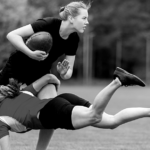Complex training (sometimes referred to as contrast training) applies a post activation potentiate training effect by enhancing the neuromuscular system, with the athlete firstly completing a resisted training movement before completing a plyometric based training activity. The theory being that the first resisted movement increases the level of motor unit recruitment, motor neuron firing rate frequency and intra-muscular calcium concentrations, all of which result in an enhanced performance of the proceeding plyometric based exercise. This enhanced training effect is referred to as post activation potentiation and is an area of current active research within sports science.
Complex Training Considerations
Smilios et al (2005) previously investigated the acute effects of complex training involving loaded half squats and loaded jump squats on counter movement jump performance at varying loads, and found that both loaded half squats and loaded jump squats significantly improved counter movement jump performance in athlete populations. The authors concluded that contrast loading of low to moderate loads can lead to short-term increases in vertical jump performance. Baker has previously highlighted the importance of load selection when implementing complex training methods, suggesting that practitioners should design complex-training training interventions that incorporate exercises from within the speed-strength range of the force-velocity curve profile followed by exercise situated at the high velocity end of the force-velocity curve (Baker and Newton, 2005). This ensures that the motor neuron rate coding is similar for both training modes as both exercises would be performed at high velocities.
Antagonist – Agonist Method
Another complex-training training approach suggested by Baker and Newton (2005) involves performing a movement that recruits the antagonist muscularity vs the proceeding agonist movement. The authors hypothesised that the weak antagonist muscles may limit the speed of movement and that strengthening the weak antagonist may lead to an increase in agonist muscle movement speed and power output. The authors reported that the participant group that performed bench pulls between a bench throw performance test demonstrated significant increases in power output. These findings demonstrate that both agonist-agonist (or same movement pattern) or antagonist-agonist complex training may be advantageous to increasing power production in athletes.
Intra-complex Rest Considerations
Comyns et al (2006) previously highlighted the importance of adequate recovery periods between each complex exercise (intra-complex) and between each set (intra-set) was of great importance when implementing complex training methods. The authors suggested that the required rest intra-complex rest period may be athlete dependent and should be longer, rather than shorter in duration. Therefore, intra-complex rest periods of 3-4 minutes are recommended when performing complex training with athletes.
Complex training offers an effective means of increasing power output in athletes, whilst utilising both speed strength and plyometric training within a short time scale, therefore making complex training a time efficient training mode within strength and conditioning practice. However, practitioners should be aware of the neuromuscular demand of complex training, and therefore consider how it is scheduled within the overall periodised training plan and the athletes overall training status.
Baker, D. Newton, R, U. (2005). Acute effect on power output of alternating an agonist and antagonist muscle exercise during complex training. Journal of Strength and Conditioning Research. 19(1), pp. 202–205.
Comyns, T, M. Harrison, A, J. Hennessy, L, K. Jensen, R, L. (2006) The optimal complex training rest interval for athletes from anaerobic sports. Journal of Strength and Conditioning Research. 20(3), pp. 471–476.
Smilios, I. Pilianidis, T. Sotiropoulos, K. Antonakis, M. Tokmakidis, S, P. (2005). Short-term effects of selected exercise and load in contrast training on vertical jump performance. Journal of Strength and Conditioning Research. 19(1), pp. 135–139.


